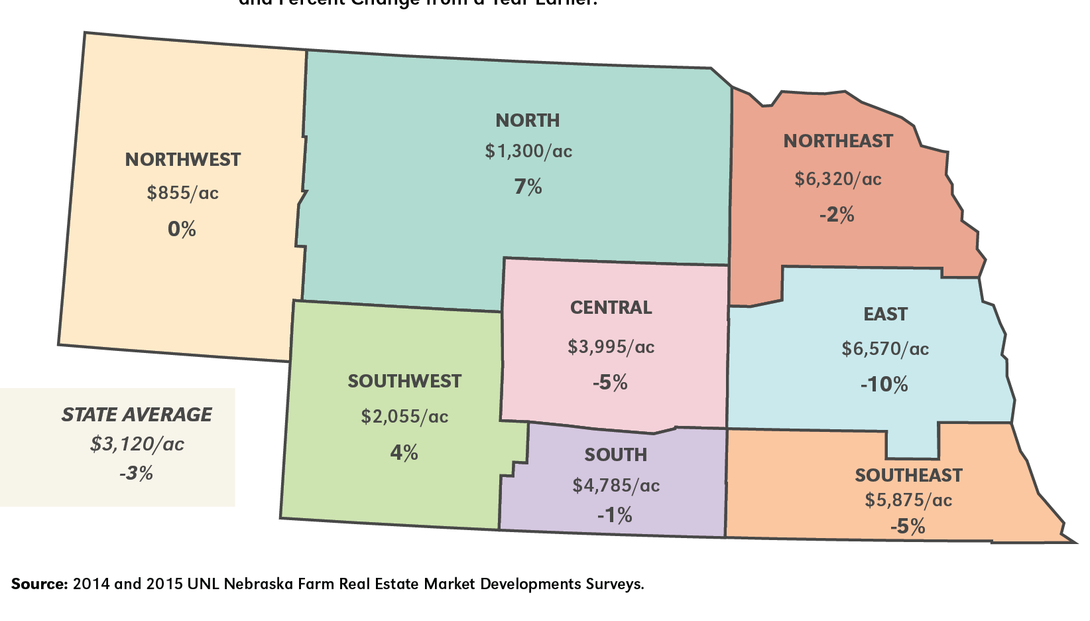
After five years of increases in Nebraska farmland values, the state average dropped 3 percent, according to preliminary findings released March 4 by UNL.
The state average farmland value as of Feb. 1 was $3,210 per acre, down 3 percent from the 2014 average of $3,315. Average farmland values in six of the state’s eight districts (illustrated in the accompanying state map) decreased or remained the same.
The average land value in the southwest district increased by 4 percent to $2,055 an acre while the value in the north district increased 7 percent to $1,300.
Average farmland values for the other six districts and the percentage decrease from 2014 were: northwest, $855 (0); northeast, $6,320 (minus-2 percent); central, $3,995 (minus-5 percent); east, $6,570 (minus-10 percent); south, $4,785 (minus-1 percent); and southeast, $5,875 (minus-5 percent).
Generally, grazing and haying land-use categories showed increases while irrigated and dryland cropland showed smaller increases or decreases. The statewide average value for hay land increased 20 percent from 2014, the highest of any statewide land use category. The state average for non-tillable grazing land increased 12 percent; tillable grazing land increased 7 percent.
“Land classes that support the cow-calf industry are improving or holding steady due to a strong return in that market over the last one to two years,” said Jim Jansen, UNL extension educator and co-author of the Nebraska Farm Real Estate Market Developments survey.
The survey covers the period from Feb. 1, 2014 to Feb. 1, 2015 and is reported in the current Cornhusker Economics, written by Jansen and Roger Wilson, UNL Farm Management Budget Analyst. The article is available online at agecon.unl.edu/cornhuskereconomics. Cornhusker Economics is a publication of the UNL Department of Agricultural Economics.
“Irrigated crop ground classes, including center pivot or gravity irrigated, did not decline as quickly in value as the dryland categories. Their yields, and similarly their revenues, are not as variable as the dryland acres,” Jansen said. “That’s why we’re still seeing some pretty strong values there.”
The state average decrease for gravity-irrigated land was 4 percent and for center pivot-irrigated land it was 2 percent, compared with a 10 percent decrease for dryland acres with irrigation potential and a 9 percent decrease for dryland acres with no irrigation potential.
“Bearish comments reported by survey participants indicated lower expected grain and oilseed prices led to the lower tends in dryland cropland values in Nebraska,” Jansen wrote. The higher grazing and hay land prices may reflect the $532.5 million in federal disaster relief that Nebraska livestock growers had received as of Jan. 6 for 2012-14 forage losses because of drought.
“These payments lessened the impact of prior losses and may have provided financial incentive to expand cattle herds and add resources to change the size or scope of an operation,” Jansen said. Comments from survey participants indicated a bullish outlook for classes of land that support the cow-calf industry and a more varied outlook for cropland where expectations were tied to the commodities being raised on the land.
“Pasture and cow-calf pair rental rates continued to set new records for 2015,” the authors reported. Cow-calf pair rental rates across Nebraska for the upcoming five-month grazing season in 2015 average about $50 per month or $250 for the season.
Rates based on cow-calf pairs were lower in the north district, unchanged in the central district but increased in all other districts, with the southwest, south, and southeast showing the largest increases at 35, 45 and 50 percent, respectively.
Changes in cash rental rates for cropland ranged from an increase of 5 percent for dryland parcels in central Nebraska to a drop of 18 percent for center pivot-irrigated cropland in the southwest district, with most cropland decreasing 5 to 15 percent.
Land managers voiced concerns about increasing property taxes at a time when commodity prices had dropped and land prices were just starting to fall off, Jansen said. “Folks are trying to negotiate higher rents while tenants are feeling profit margins starting to decrease due to lower commodity prices, creating a tug-of-war throughout the crop and livestock land classes,” he said.
This may be a good year for landlords and tenants to look at the benefits of flexible cash leases, Jansen said. With flexible cash leases, both parties agree to a base rental rate and an additional amount that flexes around crop yield, crop price or crop revenue (yield times price). More information is available in the UNL publication Flexible Cash Leasing of Cropland at http://www.ianrpubs.unl.edu/sendIt/ec862.pdf.
Results are preliminary findings from the UNL 2015 Nebraska Farm Real Estate Market Survey.
Land values and rental rates presented in the report are an average of survey participants’ responses by district. Actual land values and rental rates may vary depending upon the quality of the parcel and local market for an area. Preliminary land values and rental rates are subject to change as additional surveys are returned. Final results will be published in early June and will be available electronically on the Nebraska Farm Real Estate website at http://agecon.unl.edu/realestate.html.
Land appraisers, farm managers or agricultural finance professionals interested in participating in future Nebraska Farm Real Estate Market Surveys can contact the Department of Agricultural Economics at 402-472-3401 or agecon@unl.edu.







